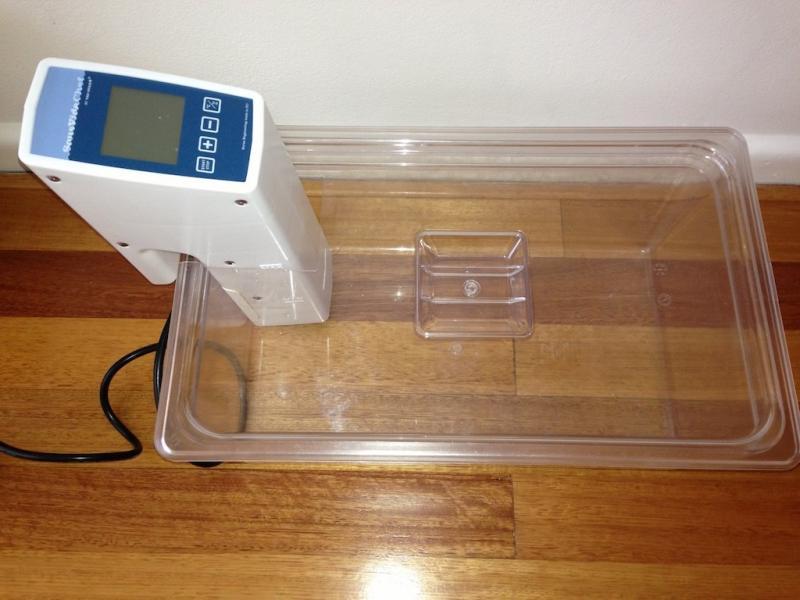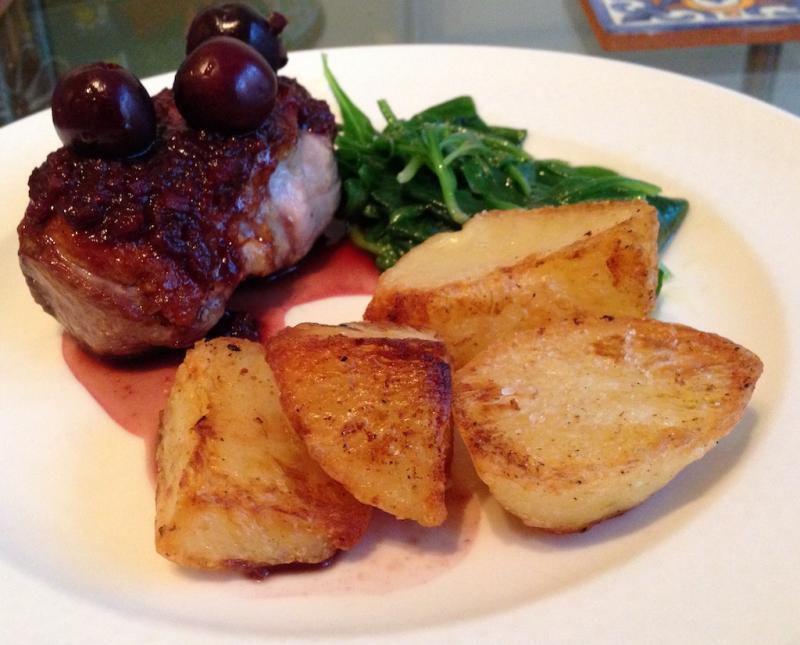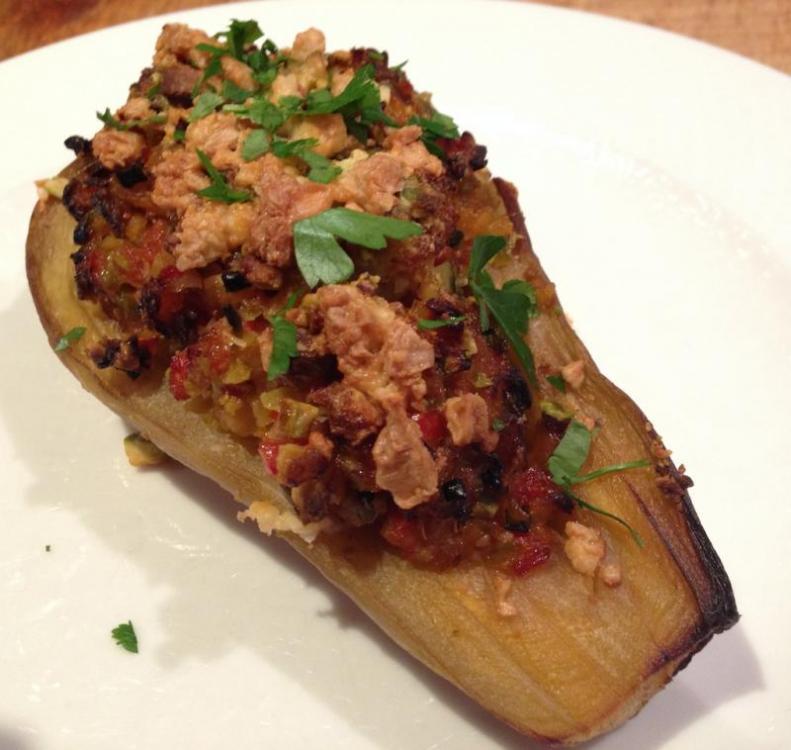-
Posts
2,606 -
Joined
-
Last visited
Content Type
Profiles
Forums
Store
Help Articles
Everything posted by nickrey
-
I made up some feta a few days ago and followed my normal recipe, draining the cheese in a mould, then placing on a rack to drain, then drying for a few days. At this stage, I put it in a 23% brine solution for the time recommended in Mastering Artisan Cheesemaking. I then put it in a 10% brine solution and into the fridge to cool down as I intended vacuum sealing the cheese in bags. The cheese felt a bit spongy and not like feta but I felt that brine maturing it would make it more like traditional feta. On vacuum sealing it this morning, I noticed an interesting phenomenon that I thought I'd share. When the vacuum was drawing out the air prior to sealing a lot of air bubbles came out of the cheese. When the seal was made and the vacuum released, the cheese compressed and suddenly became the texture that I associate with feta. I haven't cut it open yet as I want to let it mature for a while in the brine. Will post a picture here when I do. My reason for posting this here is that after normal draining and some drying, it may be worthwhile experimenting with using a vacuum to modify the texture of appropriate cheeses. I use the same technique with fruits such as watermelon to give a very interesting texture. Has anyone else tried this with cheesemaking?
-
If you dry it and it falls off, perhaps blether is right. Worth a try.
-
I made the mistake of reading this before breakfast. What can I cook after this? Really looking forward to the rest. Thanks for sharing.
-
I use my pressure cooker without the lid when cooking for up to four. For larger groups or longer cooks I use a 20 litre polycarbonate container with a lid that I got some professional plastics people cut a hole in (polycarbonate has a habit of splitting if you don't use the right equipment and technique). It works very well and has minimal evaporation over long cooks.
-
I quite often make sauces for casseroles or curries via conventional means and then add sous vide cooked meat to give a different perspective on the meal. To achieve flavour integration, after the sauce and meat are cooked separately they can be chilled and combined, much like marinating meat. You then reheat the dish gently and serve. I can't see why you couldn't do the same thing with soup by creating a base through conventional means and then adding the cooked meat afterwards. With regard to soup being flavoured water, typically bases for soups are stocks. In creating stocks, it is conventional and sensible to have maximum flavour extraction. This gives highly flavoured water and is why conventional cooking simmers the bones for long periods of time and why the "modernists" (I'm really staring to dislike that word, it conjures up images of people with flares, sideburns, and perms from the 70s); anyway, why the modernists use pressure cookers.
-
Why take it to 70C when you reheat it? You're already taking the food well past the point of pasteurisation when cooking and will not have opened the package. Personally I wouldn't take the core temperature above 60C (use the cooking temperature time charts to see how long this will take when reheating in sous vide). If you have an iPhone, buy the sous vide dash app and you will have all the cooking times to temperature on hand.
-
I'm perplexed by breaking spaghetti to get it into a pot. If you add it to boiling water it rapidly becomes bendable and you can fit it easily into whatever shaped pot you have. On cheese with fish, the only rationale that I have is if you use umami-rich parmesan, the taste could swamp the taste of fish. Otherwise, I suspect it is a leftover from the church-driven food rules introduced during periods of austerity.
-
My first reaction was that it is a sauté pan. Look this term up in google images and there it is.
-
I recall Ranchogordo calling gas a "gift with purchase" so am not sure that he'll have too many solutions.
-
Are you still thinking lentils, then?Not at all, however those who saw what it was recognized the whole dish from a picture in a book and then adduced the presence of caviar. This does not make it an obvious choice, particularly when there are sustainability issues around this ingredient.I wasn't criticising your picture per se instead I was simply asking for a clearer one if you are asking us to guess the ingredients from visual cues alone. Degrading a picture is used in experiments to make such tasks more difficult, as it did here.
-
Caviar has a strong reflective sheen. I don't get that in this picture.
-
Try 57C for 48 up to 72 hours. An example of the product is here.
-
Check out this article by Douglas Baldwin for a good discussion of factors involved in sous vide cooking. The New South Wales Food Authority has a very good guide on food safety precautions for sous vide in restaurants. The golden rule for long time low temperature cooking is to reach 55C internal temperature within six hours (or four if you are more conservative). Two points. First your temperature seems high compared to what others of us have used. Check the index link given by gfweb above to get some information on times and temperatures. Second, you can hold the meat for service as long as you keep the temperature above 55C. Chill and reheat works well but make sure you chill in an ice bath (ice and a bit of water, not water and a few bits of ice). You can then keep refrigerated or freeze. Reheat for service by immersing in a water bath 55C or above.
-
I was really pleased with them. 20 minutes in boiling water followed by draining, cooling down and letting them lose liquid. I then heated oven to 180C (350F) with duck fat in the pan. Added potatoes and turned them frequently for the first ten minutes or so as they seemed to be frying in the oil. Cooked for around 15-20 minutes after this turning every five minutes or so. They were the best I've ever done. Crispy on outside and feather light inside.
-
So what is it? I'm thinking puy lentils on salmon "cannelloni" with cream cheese filling, shaped lime, basil and tomato flower with dill. No, that's not it. Maybe a better picture next time if you are going to play mystery dish?
-
So what is it? I'm thinking puy lentils on salmon "cannelloni" with cream cheese filling, shaped lime, basil and tomato flower with dill.
-
The steak was too thin for this type of treatment. At the temperature suggested with that thickness it would have reached core temperature after only 13 minutes. The steak would have been pasteurised at 1hour 32minutes. You gave it another 30 minutes and you blowtorched a 7 mm steak before commencing. No wonder it was overcooked. Grab a 3cm steak and subject it to the same treatment (or possibly another 15 minutes to be pasteurised) and see if that is overcooked for your taste before blaming temperatures.
-
Cherries are in season here. Duck breast with cherry sauce, duck fat roasted potatoes and Australian native Coorong spinach.
-
And lots of lots of European chefs still say that searing meat over high heat seals in the juices. Just because a chef says it doesn't make it right. Nice story though.
-
If the wine is the hero of the party, I'd steer away from dishes with heaps of Chili. Wine and heat are not happy bed-fellows. I know the bread/charcuterie/cheese may seem boring but it is good food to have with wine and the bread in particular will soak up the alcohol. If you want to get a bit fancy, get some melon cubes, wrap them in prosciutto and serve on toothpicks. As a surprise/finishing touch, if you can get some of the box-like take-away Chinese containers, I'd do an easy Asian dish (without heaps of chill) that can be pre-made and heated on one of your hot plates. Use your microwave to make rice (add rice, rinse, put in water so it sits one knuckle above the height of the rice, cook on full for 12 minutes, take rice out, sit for eight minutes and serve). Put more rice in to cook as soon as you take the first lot out to rest. Serve the rice with the Asian dish in the containers. Accept compliments on being clever in feeding people with something substantive after they have had a few wines.
-
Salt. Experiment with the amount. If you've got it right, you will be happy to eat the pasta without a sauce because it tastes so good. Keep the good quality oil for drizzling over your completed dishes.
-
This is very sad news. Dave gave us all so much pleasure with his writings. It was a privilege to be taken into his world. Condolences to family and friends. He will be missed.
-
Heated milk plus a small amount of vinegar = ricotta cheese. This was something of a revelation when I found out about it.
-
Another vegetarian dinner. Baked eggplant stuffed with fine cut ratatouille, crushed pistachios, and crumbled fetta.
-
Prawns (shrimp) are something that I'd only do sous vide if I had the best quality available and wasn't worried about pasteurising them (ie. you'd need to be confident eating them raw). Anything nearing pasteurisation is going to make them rubbery. The aim is to get them just cooked through. For sous vide prawns, I wouldn't go over 45C (113F) for 20 minutes. Over higher heat, this is done by turning them when the white hits just below the middle of the prawns before turning and taking off after less time and letting residual heat cook through. The higher heat hits the outside where many possible contaminants would be found. As a consequence if I was not as confident in my produce, I'd be cooking over a higher heat.






